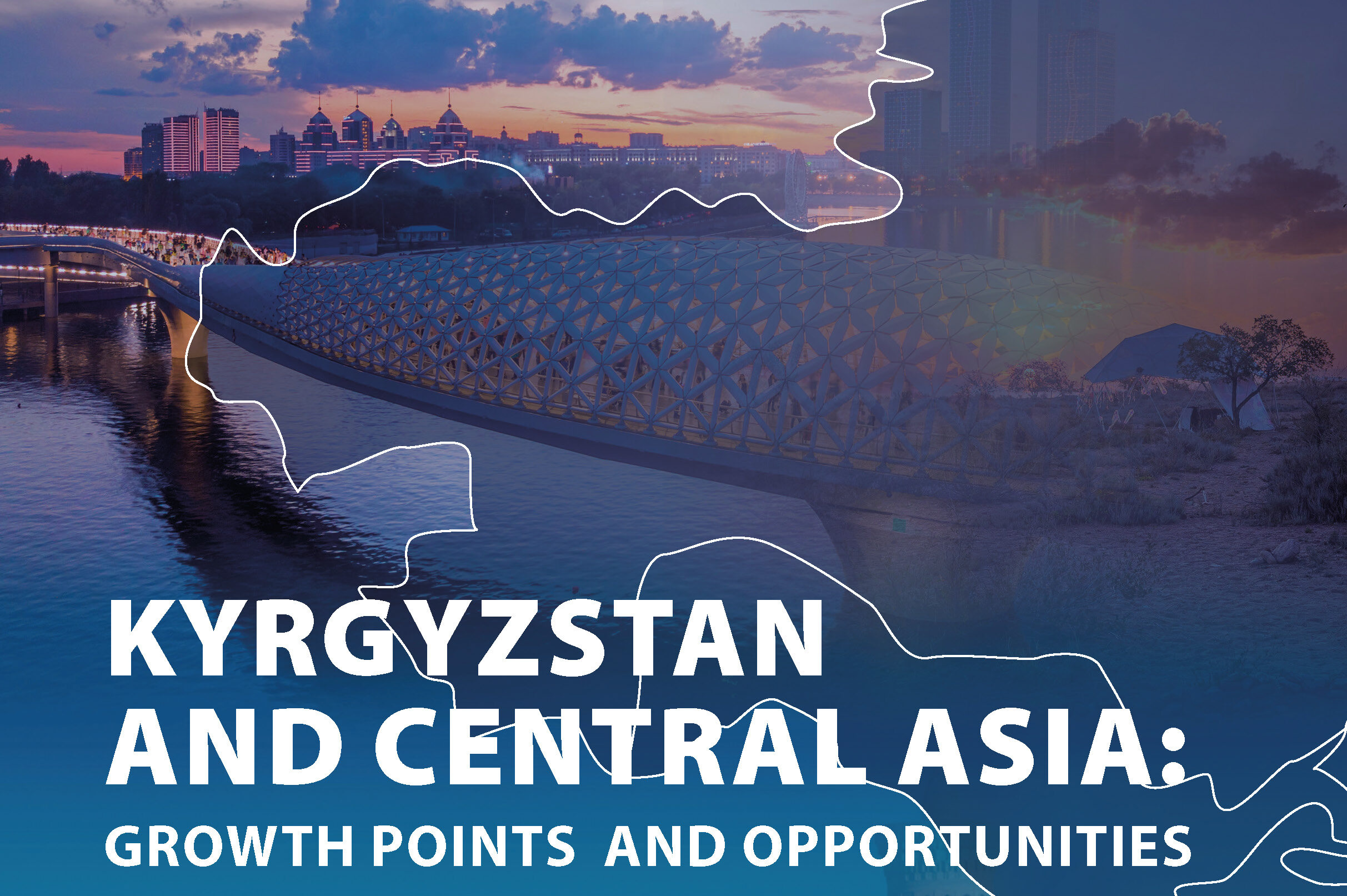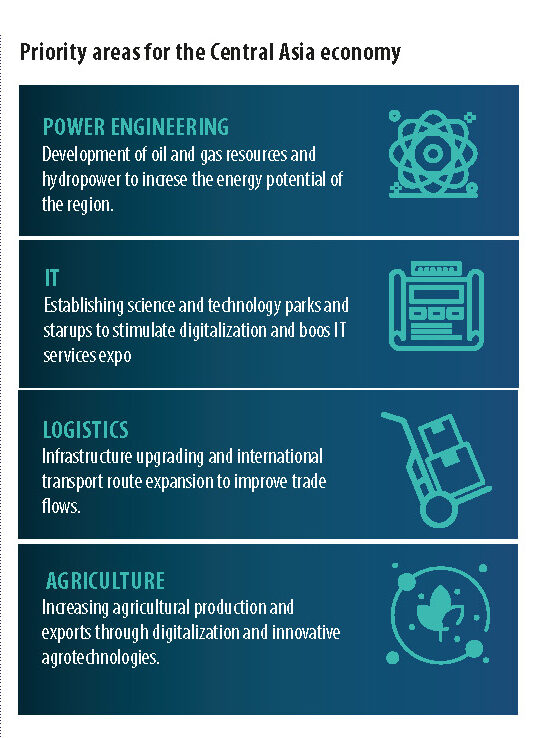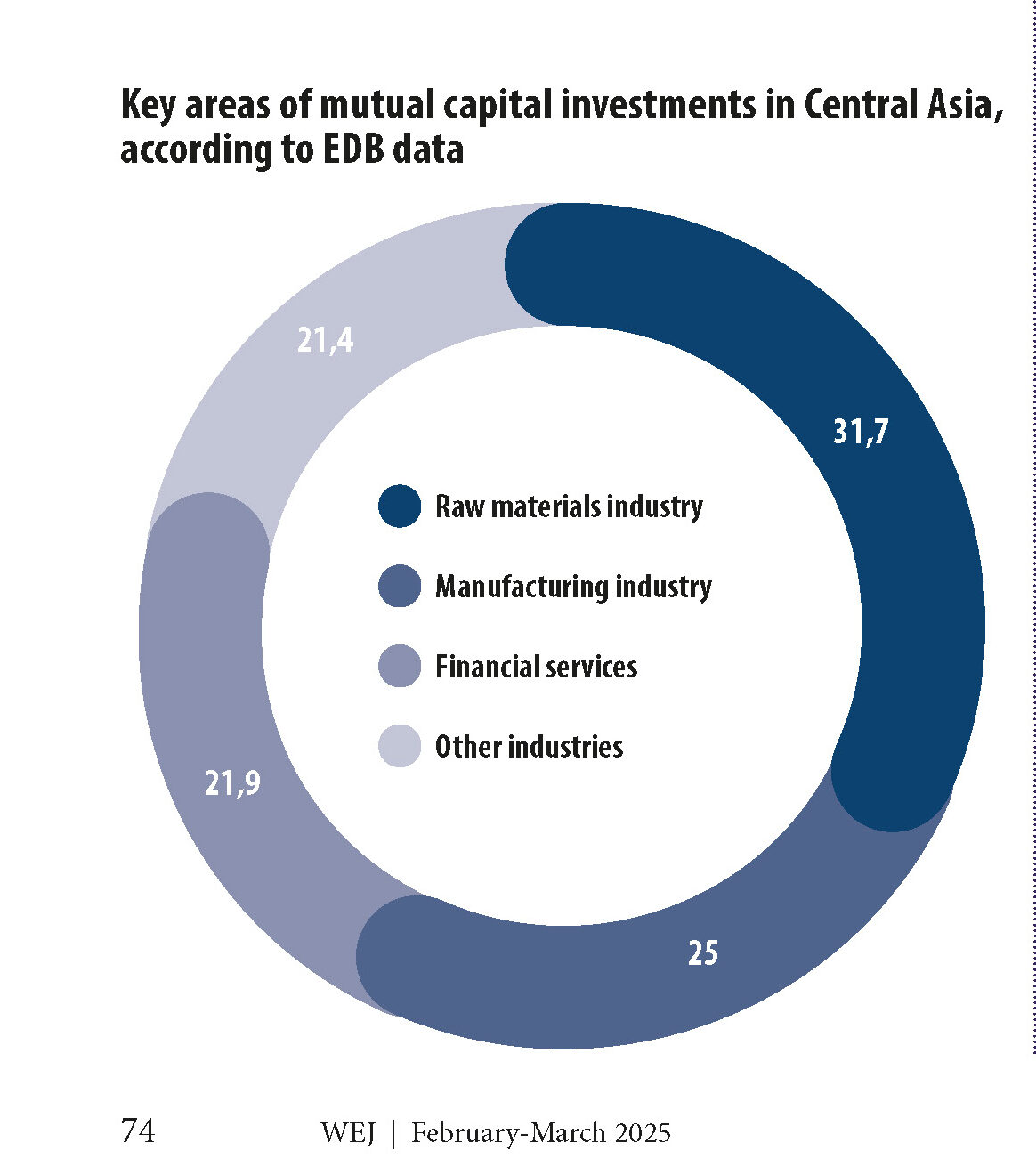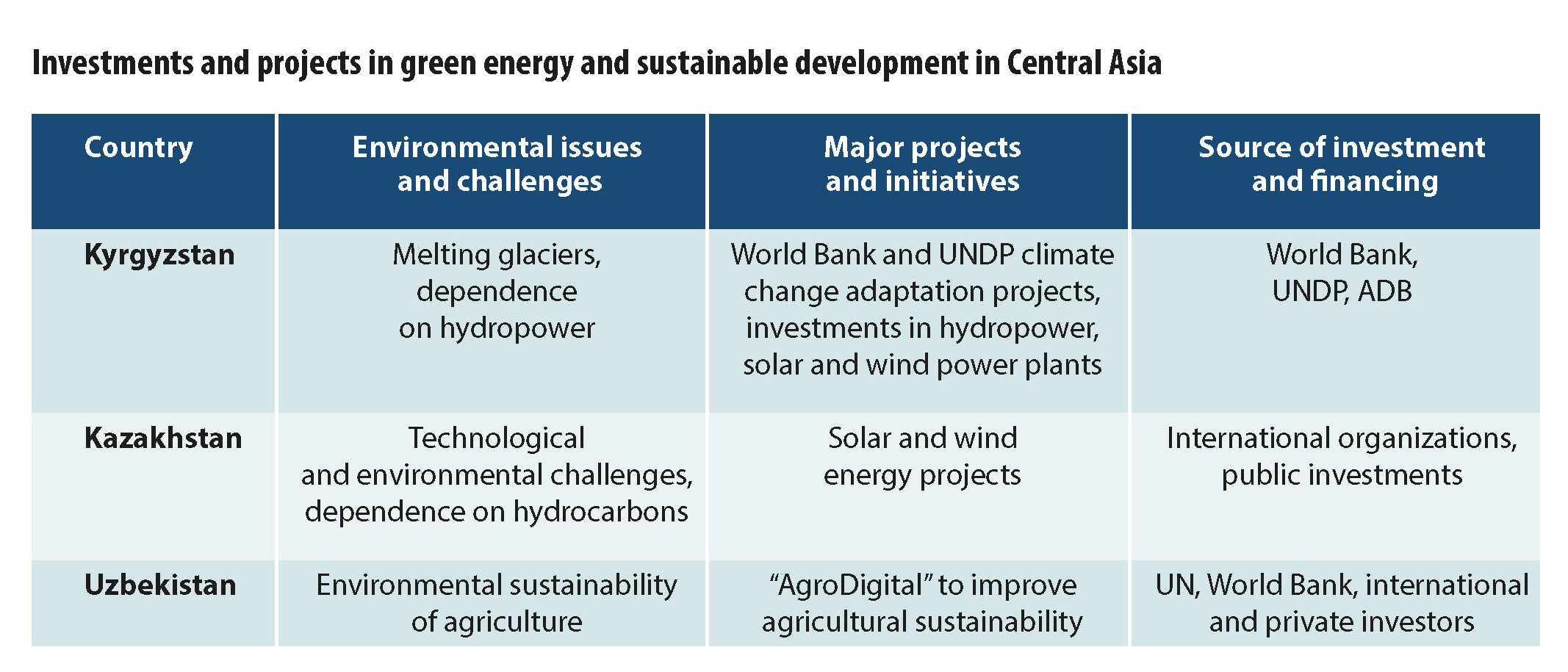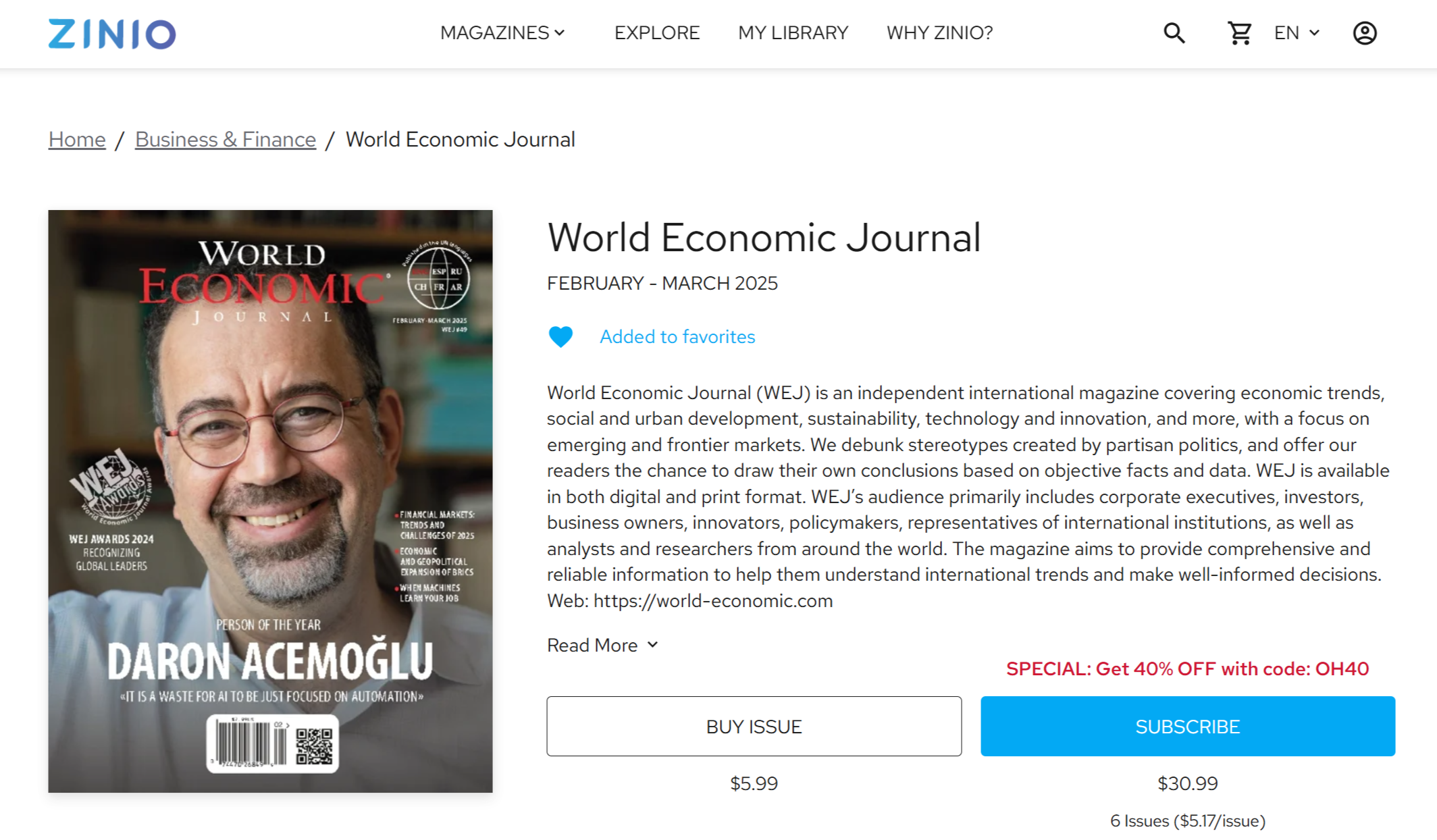Сentral Asia is experiencing a new stage of development. Historically, the region has been dependent on the export of raw materials, which has made it vulnerable to fluctuations in world prices for oil, gas, metals, and other resources. In response, countries in the region have begun to look for ways to diversify their economies.
Kazakhstan is emphasizing the development of the IT sector and renewable energy. Uzbekistan aims to become a center for manufacturing and trade. Kyrgyzstan is also developing tourism, agriculture, and hydropower. However, Central Asia’s economic growth also faces serious challenges. One of the main challenges is climate change. For example, melting glaciers in Kyrgyzstan’s mountains threaten the stability of agriculture and hydropower.
Geopolitical instability is also putting pressure on the region’s economy. Sanctions against Russia, a major trading partner, and ongoing instability in neighboring Afghanistan add further risks.
Nevertheless, these challenges also present new opportuni- ties. Sanctions against Russia are forcing European countries to look for alternatives, and Central Asia is becoming an important link in the supply chain. The “One Belt, One Road” export corridor, which links Europe, China, and the Middle East, has taken on a special significance. Central Asia now has the opportunity to reduce dependence on individual countries and strengthen economic cooperation with different partners.
Green energy is one of the most promising areas for growth in the region. Kazakhstan and Kyrgyzstan are already investing in hydroelectric, solar, and wind power plants, allowing the regions to reduce dependence on hydrocarbons and create conditions for exporting clean energy.
In addition, international organizations play a significant role in addressing the region’s climate challenges. The World Bank and UNDP (United Nations Development Programme) actively support climate change adaptation projects in Central Asia, which helps the countries of the region cope with the effects of melting glaciers and other environmental challenges.
Central Asia has significant potential for sustainable development. The region is actively seeking new avenues of growth, developing new industries, and strengthening international ties. New opportunities lie ahead for Central Asia that can lead to longterm economic prosperity. Today, Central Asia is not just looking for solutions to its problems but is also actively seizing unique opportunities for development. Economic diversification, strengthening international ties, and the transition to sustainable energy are already beginning to yield early
results. It is important to un- derstand which growth points can take the region to the next level and ensure its resilience to global challenges.
Economic diversification, strengthening international ties, and the transition to sustainable energy are already beginning to yield early results
GROWTH POINTS IN THE REGION
The geographical layout allows Central Asia to focus on the development of key economic sectors such as energy, logistics, IT, and agriculture.
One of the key and strategically critical sectors is energy. Parts of the region (Kazakhstan, Turkmenistan, and Uzbekistan) are rich in various natural resources such as oil, gas, and coal. The countries in the region have total oil reserves of 15-31 billion barrels and total natural gas reserves of 230-360 trillion cubic meters. Meanwhile, the rest of the region (Kyrgyzstan and Tajikistan) is focused on hydropower. This mixed energy system is economically efficient. Kyrgyzstan, for example, has 30% of the region’s water resources. The country not only covers its domestic energy needs but also develops exports.
According to a report by the Asian Development Bank, the region’s energy demand will grow by 32% by 2030. Therefore, Central Asia is interesting as a source of raw materials and energy. International communities and countries are paying attention to the potential of Central Asia and launching projects aimed at developing the region. One of the most promi- nent energy projects is CASA-1000 (Central Asia South Asia Electricity Transmission and Trade Project). The World Bank supports it and aims to build infrastructure that allows the export of surplus electricity from some Central Asian countries to Afghanistan and Pakistan. Thus, the project stimulates energy development in Central Asia.
Major trade routes that connect Europe and Asia pass through Central Asia. This strategic location allows the region to develop logistics. The volume of transportation has increased significantly over the past five years. And Kyrgyzstan accounts for the majority of logistics chains. Trade flow between the countries is growing due to the development of international road transportation, which complements transportation by rail.
The revival of the Silk Road in the Belt and Road initiative allows Central Asia to develop transport infrastructure and upgrade roads and rail networks. The region still faces difficult logistics and transport inaccessibility with some countries, such as India, which prevents transportation from being cheaper and increases trade volumes. However, some Central Asian countries, such as Kyrgyzstan, are establishing trade and logistics centers to address such problems.
“The region is well endowed in natural resources, and each country has the potential to significantly increase investments in domestic sources of renewable energy—whether solar, wind, geothermal, bioenergy or green hydrogen—which will contribute to energy security,” said Stephanie Gil, Practice Manager for Europe and Central Asia in the World Bank’s Energy and Extractives Global Practice.
Another initiative in this sector was the Uzbek-Kyrgyz cross-border trade platform. This is a prime example of how the region has introduced digital technologies in logistics development. The platform optimizes trade routes and simplifies customs processes, which helps increase the flow of goods between the countries.
And speaking of digitalization, another driver of Central Asia’s growth is the IT industry. Kazakhstan, Kyrgyzstan, and Uzbekistan are creating their own technology parks and IT hubs, which are attracting more investment in the sector. A growing number of startups are appearing, digitalization is increasing, and IT solutions are being introduced into various areas of the economy. Kazakhstan, Kyrgyzstan, and Uzbekistan are launching university programs in programming, AI, and cybersecurity, which is contributing to an increase in IT experts.
Central Asian countries were among the first to recognize the potential of artificial intelligence technology. For exam- ple, the President of Kazakhstan, Kassym-Jomart Tokayev, urged the country’s specialists to use all the possibilities of AI. This technology is already being integrated into many areas of activity, such as digital government, fintech, agriculture, healthcare, and transportation.
“I think that the use of AI technologies in Kazakhstan has significant potential to ensure GDP growth by increasing productivity, improving the quality of products and services, developing new industries, and effective resource manage- ment. Research work is being carried out in research institutes and universities. Many grants are allocated by the government for IT development”, emphasizes Asel Abdildayeva, PhD, associate professor.
IT outsourcing is also becoming a priority for the region. The High Technology Park of Kyrgyzstan (HTP) has become a national success story. The project supports IT startups through tax incentives and access to international markets.
Another Kyrgyz IT services project was Taza Koom. This initiative makes online services for the population more con- venient. By the way, the Taza Koom project is supported by the UNDP and the World Bank. This also shows that international society believes in the IT potential of Central Asia.
In 2023 only, Kyrgyzstan was able to realize $10 million through the export of IT services. Meanwhile, Kazakhstan’s IT exports grew by 40% over the same period. Overall, the services sector in Central Asia will reach almost 300 billion dollars in 2024.
Agriculture is another important area of economic devel- opment in Central Asia. Its share in the region’s GDP is about 20%. If we look at some economies, in Kyrgyzstan and Tajik- istan, this figure is above 20%, and in Kazakhstan, it is 4.5%. In general, Central Asia relies on agriculture. Its countries are gradually moving away from growing only traditional crops such as wheat, barley, and millet. Uzbekistan, for example, is developing the production and export of fruits and vegetables.
In addition, the government of Uzbekistan, together with the UN and the World Bank, has launched the AgroDigital project. This is an ideal example of how digital technologies are applied in agriculture. The online platform helps local farmers with planning, efficient resource use, and access to markets and supply chains. With this platform, they can also analyze soil conditions, check the weather in real-time, and more.
It’s worth highlighting that large organizations and coun- tries are actively investing in the development of Central Asia.
According to EDB data, last year alone, direct investment in the region amounted to more than $1 billion. The distribution of investments in the region in 2023 was largely focused on raw materials, manufacturing, and financial services. Specifically, 31.7% of all mutual investments were directed to primary indus- tries, 25% to manufacturing, and 21.9% to financial services.
Overall, Central Asia is actively developing its priority sectors. And digital transformation is behind it all. The region is competently implementing and using digital solutions to overcome the barriers of geographical location and insufficient infrastructure. The development of IT technologies directly affects the development of other priority areas of the Central Asian economy. And vice versa, further growth of key industries stimulates the countries to further develop the IT direction.
One of the most striking examples of successful attempts to develop these key areas is Kyrgyzstan. The country is actively innovating and strategically developing various sectors, from information technology to agriculture and energy. Kyrgyzstan is making significant progress in strengthening its economic base and improving its infrastructure. The steps the country is taking now allow it to become an important player in the context of Central Asia’s growth.
FOCUS ON KYRGYZSTAN
Kyrgyzstan’s economy is set to grow by 8.1% in 2024, accord- ing to the World Bank. The country’s economy shows positive changes, mainly due to the growth of exports, consumption, and investment. This year, exports increased by 28.2%, amounting to 2.8 billion dollars. Gold remains the key raw material for export: 50% of the total.
In the first six months only, Kyrgyzstan exported more than $1 billion worth of gold, of which 11 tons were shipped to the UK for $870.5 million, 1.8 tons to China for $129.4 million, 971.4 kg to Switzerland for $63.5 million and 13.5 kg to the UAE for $881,900, according to the Kyrgyz government.
This shows that Kyrgyzstan is still highly dependent on gold and other natural resources, which do
not allow the country to fully diversify its economy.
However, it is interesting that some sectors where Kyrgyzstan can achieve sustainable development also saw growth. In agriculture, output growth amounted to 3.3%. Domestic investment grew by 52.1% and external investment by 69.6%. This year, the volume of investments in the IT sector of Kyrgyzstan especially increased. The country continues to actively cooperate with international organizations to implement projects in the field of digitalization.
Nevertheless, Kyrgyzstan’s economy continues to depend on foreign trade. The budget deficit, limited domestic resources, and geopolitical instability create additional pressures on the country’s economy. Russia and China are important trading partners of Kyrgyzstan, so fluctuations in the economies of these two countries negatively affect Kyrgyzstan. Kyrgyzstan has a rather strategic location, being in between the major economic centers of Eurasia. Therefore, diversification and a focus on new areas such as IT, agribusiness, logistics, and green energy are necessary to stabilize the economic situation in Kyrgyzstan. Special attention should be paid to investments in
infrastructure and logistics to stimulate international trade.
Hydropower remains an essential attraction for investors. Kyrgyzstan has all the resources to produce, develop, and export clean and cheap energy. Organizations such as the World Bank and the Asian Development Bank (ADB) are actively investing in Kyrgyzstan’s “green” energy sector, helping the country modernize facilities and more.
For example, $500 million from international organizations and private investors has been directed to the Naryn River hydropower project. In addition, a significant part of investments is directed to solar and wind energy.
Investors are also paying attention to the IT sector of Kyrgyzstan. The government has created a favorable ground for the development of new projects and startups in the industry, thanks to the introduction of various preferential tax programs and educational projects. In 2024, Kyrgyzstan’s investment in the IT sector has been growing. According to the World Bank, the volume of foreign direct investment in the digital technology sector for 2023 amounted to about $12 million, which is 1.5 times more than in 2020.
Important projects were AgroDigital and E-Gov. The first one is aimed at using new digital technologies in agriculture to improve its efficiency. And the second one is aimed at digitalization of public services.
In recent years, the agricultural sector has attracted significant investment, with agrotechnologies becoming particularly promising. Kyrgyzstan has attracted more than 100 million dollars of foreign direct investment in the agricultural sector by 25%. Key areas are the development of infrastructure for crop storage and processing, as well as the application of inno- vative solutions to increase yields and adapt to climate change.
The United Nations Development Programme (UNDP) is actively involved in the development of digitalization and implementation of IT-technologies in various fields in Kyrgyzstan. One of the latest initiatives was e-сommerce. Experts noted the importance of IT innovations in the development of e-commerce.
One prominent example is the introduction of precision farming technology based on the use of sensors and monitoring systems to optimize irrigation, fertilization, and pest control. In 2024, foreign companies have invested more than $40 million in modernizing agricultural infrastructure.
International cooperation plays a key role in supporting Kyrgyzstan’s economy. Organizations such as the United Nations (UN), the World Bank (WB), the European Bank for Reconstruction and Development (EBRD), and the Asian Development Bank (ADB) have paid attention to the country. Together, they address systemic economic and social problems such as poverty, infrastructure improvement, human capital development, and support for small and medium-sized businesses.
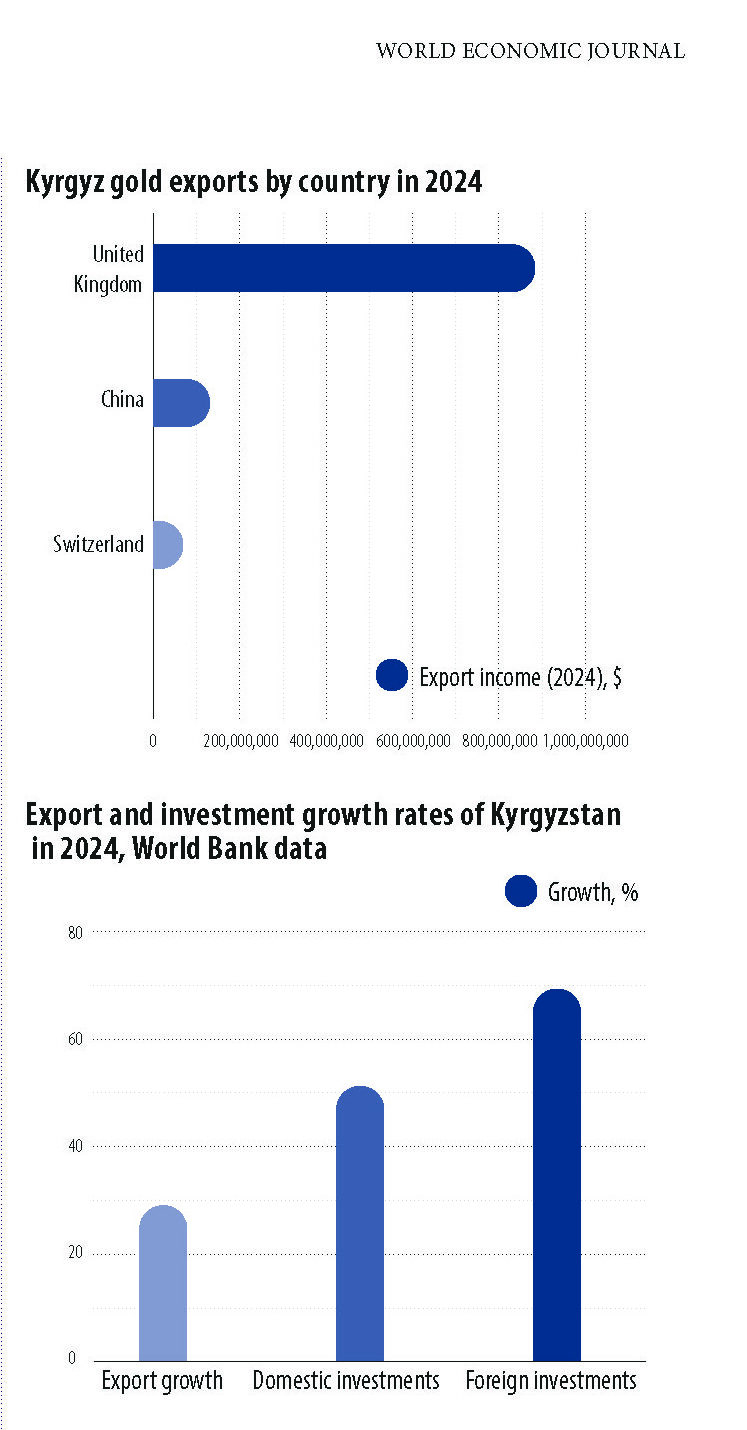 The UN implements sustainable development programs and covers environmental issues, gender inequality and inclusive economic growth. For example, UNDP focuses on initiatives to adapt to climate change and modernize the agricultural sector, which remains the main source of employment in Kyrgyzstan.
The UN implements sustainable development programs and covers environmental issues, gender inequality and inclusive economic growth. For example, UNDP focuses on initiatives to adapt to climate change and modernize the agricultural sector, which remains the main source of employment in Kyrgyzstan.
Meanwhile, the World Bank is investing in infrastructure projects, in addition to health and education projects. Last year, the World Bank launched several programs, including financing for energy sector modernization and improving water resources for irrigation.
The EBRD has also taken an interest in Kyrgyzstan’s energy sector, focusing on supporting the private sector in financial services and renewable energy development. The Bank is financing programs aimed at expanding exports and integrating Kyrgyzstan into international trade chains.
Speaking of trade chains, ADB is allocating funds to modernize transport infrastructure and introduce digital technologies. These initiatives are particularly important for improving logistics in Kyrgyzstan.
Indeed, it can be concluded that positive trends of sustainable development are coming in the country and in the whole region. Nevertheless, both Kyrgyzstan and Central Asia face risks that may hinder this development. Climate change, geopolitical instability and economic shifts in global and regional politics could have a significant impact on the future growth of the country’s economy and the region as a whole.
“Digital transformation is a key factor for the development of e-commerce, which in turn creates jobs, develops businesses, and supports sustainable economic growth. UNDP is committed to ensuring that the digital transformation process in Kyrgyzstan leaves no one behind, with a special focus on youth, women, rural communities, and people with disabilities,” said Alexandra Solovieva, UNDP Resident Representative.
RISKS AND PROSPECTS
The main risks facing Central Asia, including Kyrgyzstan, are climate change, geopolitical instability in the world and economic shifts. All of these hinder the sustainable development of the region. Charles Cormier, World Bank Regional Director for Infrastructure in Europe and Central Asia, once stated in a report that countries in the region must significantly increase their share of clean energy (up to 75% by 2060) and intensify efforts to decarbonize the industrial and transport sectors.
“This will only be possible with binding national commitments, targeted measures and investments”, he said. The message of his statement is a simple truth: one must act now and immediately.
A pressing issue for Central Asia is climate change. Over the past decades, temperatures in the region have increased by 1.5–2 °C, twice as fast as in the rest of the world. Kyrgyzstan is also experiencing a significant increase in summer temperatures. This year, July was the hottest month in the country. In some areas, temperatures reached 45 °C. Such extreme temperatures have a negative impact on agriculture. For example, production of cotton, a key export crop, is declining due to droughts and a lack of stable irrigation conditions. The situation is similar for wheat and rice, which are critical for food security.
The World Bank predicts that by 2100, the temperature in Central Asia will increase by another 6 degrees Celsius. These figures may seem insignificant to some, but experts assure that these temperature changes will catalyze extreme weather events. So, a sharp change of weather from drought to heavy rains will become a frequent phenomenon in the region. This, in turn, will affect agriculture and water resources in Central Asia, something that 60% of the population is heavily dependent on. And experts assure that already by 2050, 5 million Central Asians will be forced to become climate migrants.
Yes, Central Asia is now focusing on green energy development to minimize the risks of climate hazards, but this process is also under threat. Glaciers in the Tien Shan are Kyrgyzstan’s main source of water resources. They provide water for rivers, which in turn are an important resource for agriculture, hydropower, and the population. And now these glaciers are melting, rapidly losing their volume.
“From a worst-case scenario, by 2100, almost 90% of our glaciers will disappear. According to the moderate scenario, it is about 50-60%”, says Andrey Podrezov, Head of the Department of Meteorology, Ecology and Environmental Protection at the Kyrgyz-Russian Slavic University.
By 2024, about 70% of the region’s glaciers will have shrunk by 25–30%. And by 2050, a third of Central Asia’s glaciers could disappear. Given the dependence of Kyrgyzstan and other countries in the region on water resources, there is a threat of fresh water shortages for agriculture and for future generations.
While the region is taking active steps to address this problem, geopolitical instability is also hitting its economy. There is a downside to the fact that Central Asia occupies a strategically important location between major economic centers and, as a result, is actively developing.
One of the threats is the unstable situation in neighboring Afghanistan. After the withdrawal of US troops in 2021, the situation in the country remains unpredictable. Central Asia is under pressure from the migration of refugees and not only. According to the UN, since 2021, more than 1.6 million Afghans have crossed the border into Central Asian states. The wave of migration has increased pressure on infrastructure and social systems, especially in Kyrgyzstan and Tajikistan, where resources are limited. In addition, it not only affects the security of the region but also poses challenges to its economic development and investment flows.
On the other hand, the ongoing sanctions against Russia hit not only its economy but also the economies of those countries whose main trading partner it is. Central Asian countries are among them. In 2022, inflation jumped in CA countries amid sanctions against Russia: 19.8% in Kazakhstan, 16.7% in Kyrgyzstan, 13.8% in Uzbekistan, 11.2% in Turkmenistan, and 6% in Tajikistan. And while the countries of the region are still struggling with high inflation, they are taking steps to reduce the impact of economic shocks. Central Asian countries have cleverly managed to diversify their ties with the outside world; with China’s entry into the region, Russia’s economic influence has weakened. But the question arises: won’t China become just another agent of influence on the CA economy?
The global economic recession and falling oil and hydrocarbon prices are altering Central Asia, where the economy is largely dependent on natural resource extraction and exports. The region is also dependent on foreign investment from China, Russia, and Western countries. For example, it is predicted that by the end of 2024, foreign direct investment in Kyrgyzstan’s key industries could increase to 7-9%. This indicates an improving
business climate in the region, but it is also fraught with risks in the form of consequences of sanctions against Russia or dependence on capital from China and debt problems, including those related to the implementation of the “One Belt, One Road” project.
Central Asia is uniquely positioned for sustainable growth despite the risks it faces. In a world gripped by localized military conflicts and political and economic tensions, Central Asia has managed to build a dialog on security and economic cooperation and to promote the formation of new regional alliances. One of these alliances is the Shanghai Cooperation Organization (SCO), where Central Asian countries are actively cooperating with Russia and China, launching new programs to develop the region’s key industries and mitigate climate and geopolitical risks.
International cooperation in the energy sector is an important component of sustainable growth. Central Asian countries are jointly addressing environmental and energy issues. This requires time and effort to introduce green technologies, manage water resources, and develop new methods of processing natural resources. A focus on renewable energy sources will not only reduce the ecological footprint but also ensure energy security in the region.
Sustainable growth is impossible without the introduction of innovative technologies and digital solutions. Central Asia is already making significant steps in the digitalization of public services, education, and healthcare. In this case, the creation of innovation hubs and startups is an important element for stabilizing the region’s economy by optimizing processes in agriculture, logistics, and other sectors.
To summarize, sustainable growth in Central Asia depends on the countries’ ability to effectively use their resources and potential in the context of regional and international initiatives, as well as their willingness to adapt and implement new technological solutions.
By Tana Harina
PHOTO: EVGENYKZ, VLADIMIR GONCHARENKO / SHUTTERSTOCK; PHOTO: RINAT T / UNSPLASH; SERGEY ZUENOK / SHUTTERSTOCK.

